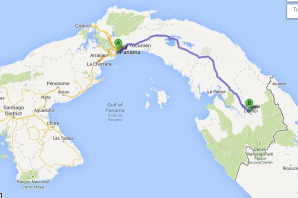Arreti, Panama
![]()
![]()
![]()
![]()
![]()
![]()
![]() Click on Programs to learn more about their work in this community
Click on Programs to learn more about their work in this community
General Information
| Population* | 600 |
| Number of homes | 150 |
| Avg # of people per home | 4 |
| Electricity | Yes |
| Corregimiento | Darien |
| District | Chepigana |
| Corresponding Health Center | Meteti |
| Distance from compounds | 2 hours |
| Road conditions | Bad |
* Population does not reflect how many patients will be seen on medical
brigades as many people from surrounding communities come seeking
Medical Brigades medical attention.
Expressed Needs and Capacities
The community of Arreti is a rural, Afro-Latino community off of the Pan-American Highway. Agriculture, is the primary source of income for the community. Arreti's community leaders have listed the following as there largest areas of possible improvement: health, economics, and renovations for their athletic field.
The community of Arreti has one school that educates children between the grades of Kindergarten and 9th grade. The school's 49 students are taught by 4 teachers, who each have a classroom. In addition to the classrooms, the school facility also has a dining room where the school provides its students with daily lunch.
Arreti's water system is powered by a turbine, rather than by gravity. The water system is maintained by a committee of community members that periodically checks up on the system. The water system was constructed in 1984. Its source is approximately 1.5 kilometers away. Panama's water department, IDAAN, is responsible for the upkeep and chlorination of the water system. In order to access this water system, community members must pay $4.00 per month; unfortunately, only about half of the community is able to pay this price to access the water system. The remaining members of the community filter their water by boiling it.
At one point, Arreti did have its own Ministry of Health health center in Arreti. However, the building has long been abandoned. Now, the closest healthcare center is in Meteti.
The most common illnesses reported in Arreti are common colds, diarrhea, and diabetes. In addition, the community members are not aware of the closest facility that provides dental care.
Most homes in Arreti are constructed using cement blocks, zinc metal sheets, and wood. Approximately 80% of the community is employed in agriculture, producing items such as corn, plantains, yuca, and rice.
In Arreti, there is no source of financial aid to receive credit. Similarly, financial education does not really exist. Despite this, there are two small stores in the community that sell small goods and basic necessities.
In the Arreti school, environmental conservation is sometimes discussed at the behest of the Panamanian organization ANAM. Usually only a quarter to a half of the students there receive this education. However, there is currently no educational curriculum that discusses waste management; community members typically dispose of their garbage by burning it. Despite the educational segments from ANAM, there is no environmental committee in Arreti, and there are currently no reforestation projects underway.
Similar to environmental issues, there is no formal legal training available in Arreti. The community does not have access to legal aid because it does not have any lawyers. In case of any legal issues, community members must travel to Santa Fe or Meteti to acquire legal assistance. The most frequent source of legal conflict is child support. The majority of the community members do have land titles for their homes.
Arreti does not have a formal local government structure. There are several committees of community members that work in Arreti: the water committee, a social club, and a religious group.
There are two other non-profit organizations that work in Arreti. Pro-Niños de Darien helps with children's activities and school, and Comedor escolar helps provide the school lunches for the community's children.
Arreti deeply appreciates the attention of our Medical/Dental brigades. The community was last visited by Wayne State School of Medicine in February 2014!
Source of information: Key informant interview
Date of interview: February 2014
Last Visited: February 25, 2014
Last Updated: March 14, 2014
